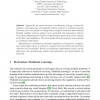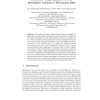388 search results - page 70 / 78 » Learning Methods for DNA Binding in Computational Biology |
BMCBI
2011
13 years 3 days ago
2011
Background: Protein secondary structure prediction provides insight into protein function and is a valuable preliminary step for predicting the 3D structure of a protein. Dynamic ...
ECAL
2005
Springer
14 years 2 months ago
2005
Springer
Abstract. Inspired by the recent advances in evolutionary biology, we have developed a self-organising, self-adaptable cellular system for multitask learning. The main aim of our p...
COMPLIFE
2006
Springer
14 years 7 days ago
2006
Springer
Abstract. This paper presents a method that uses gene ontologies, together with the paradigm of relational subgroup discovery, to help find description of groups of genes different...
ICIP
2010
IEEE
13 years 6 months ago
2010
IEEE
Representation and measurement are two important issues for saliency models. Different with previous works that learnt sparse features from large scale natural statistics, we prop...
BIOINFORMATICS
2005
13 years 8 months ago
2005
Motivation: Remote homology detection between protein sequences is a central problem in computational biology. Supervised learning algorithms based on support vector machines are ...


